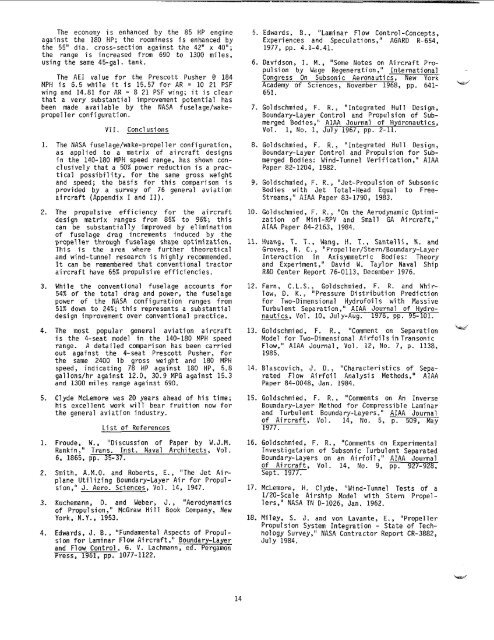Aerodynamic design of low-speed aircraft with a ... - CAFE Foundation
Aerodynamic design of low-speed aircraft with a ... - CAFE Foundation
Aerodynamic design of low-speed aircraft with a ... - CAFE Foundation
You also want an ePaper? Increase the reach of your titles
YUMPU automatically turns print PDFs into web optimized ePapers that Google loves.
The economy is enhanced by the 85 HP engine<br />
against the 180 HP; the roominess is enhanced by<br />
the 55" dia. cross-section against the 42" x 40";<br />
the range is increased from 690 to 1300 miles,<br />
using the same 45-gal. tank.<br />
The AEI value for the Prescott Pusher @ 184<br />
MPH is 6.5 while it is 15.57 for AR = 10 21 PSF<br />
wing and 14.81 for AR = 8 21 PSF wing; it is clear<br />
that a very substantial imDrovement potential has<br />
been made -available by the NASA fuselage/wakepropeller<br />
configuration.<br />
VII.<br />
Conclusions<br />
5. Edwards, B., "Laminar F<strong>low</strong> Control-Concepts,<br />
Experiences and Speculations," AGARD R-654,<br />
1977, pp. 4.1-4.41.<br />
6. Davidson, I. M.. "Some Notes on Aircraft PropLlsion<br />
bj Aage Regenerztion, International-<br />
Conqress. & Suosonic Aerona.tics, hew Yom<br />
Academy <strong>of</strong> Sciences, ?member 1968, pp. 641-<br />
651.<br />
7. Goldschmied, F. R., "Integrated Hull Design,<br />
Boundary-Layer Control and Propulsion <strong>of</strong> Submerged<br />
Bodies," AIAA Journal <strong>of</strong> Hydronautics,<br />
Vol. 1, No. 1, July 1967, pp. 2-11.<br />
1.<br />
The NASA fuselage/wake-propel ler configuration,<br />
as applied to a matrix <strong>of</strong> <strong>aircraft</strong> <strong>design</strong>s<br />
in the 140-180 MPH <strong>speed</strong> range, has shown conclusively<br />
that a 50% power reduction is a practical<br />
possibility, for the same gross weight<br />
and <strong>speed</strong>; the basis for this comparison is<br />
provided by a survey <strong>of</strong> 76 general aviation<br />
<strong>aircraft</strong> (Appendix I and 11).<br />
8. Goldschmied, F. R., "Integrated Hull Design,<br />
Boundary-Layer Control and Propulsion for Submerged<br />
Bodies: Wind-Tunnel Verification," AIAA<br />
Paper 82-1204, 1982.<br />
9. Goldschmied, F. R., "Jet-Propulsion <strong>of</strong> Subsonic<br />
Bodies <strong>with</strong> Jet Total-Head Equal to Free-<br />
Streams," AIAA Paper 83-1790, 1983.<br />
2.<br />
The propulsive efficiency for the <strong>aircraft</strong><br />
<strong>design</strong> mztrix ranges from 85% to 96%; this<br />
can be substantially improved by elimination<br />
<strong>of</strong> fuselage drag increments induced by the<br />
propeller through fuselage shape optimization.<br />
This is the area where further theoretical<br />
and wind-tunnel research is highly recommended.<br />
It can be remembered that conventional tractor<br />
<strong>aircraft</strong> have 65% propulsive efficiencies.<br />
10. Goldschmied, F. R., "On the <strong>Aerodynamic</strong> Optimization<br />
<strong>of</strong> Mini-RPV and Small GA Aircraft,"<br />
AIAA Paper 84-2163, 1984.<br />
11. Huang, T. T., Wang, H. T., Santelli, N. and<br />
Groves, N. C., "Propeller/Stern/Boundary-Layer<br />
Interaction in Axisymmetric Bodies: Theory<br />
and Experiment," David W. Taylor Naval Ship<br />
R&D Center Report 76-0113, December 1976.<br />
3.<br />
4.<br />
While the conventional fuselage accounts for<br />
54% <strong>of</strong> the total drag and power, the fuselage<br />
power <strong>of</strong> the NASA configuration ranges from<br />
51% down to 24%; this represents a substantial<br />
<strong>design</strong> improvement over conventional practice.<br />
The most popular general aviation <strong>aircraft</strong><br />
is the 4-seat model in the 140-180 MPH <strong>speed</strong><br />
range. A detailed comparison has been carried<br />
out against the 4-seat Prescott Pusher, for<br />
the same 2400 lb gross weight and 180 MPH<br />
<strong>speed</strong>, indicating 78 HP against 180 HP, 5.8<br />
gallons/hr against 12.0, 30.9 MPG against 15.3<br />
and 1300 miles range against 690.<br />
12. Farn, C.L.S., Goldschmied, F. R. and Whir<strong>low</strong>.<br />
D. K.. "Pressure Distribution Prediction<br />
for. Two-Dimensional Hydr<strong>of</strong>oils <strong>with</strong> Massive<br />
Turbulent Separation," AIAA Journal <strong>of</strong> Hydronautics,<br />
Vol. 10, July-Aug. 1976, pp. 95-101.<br />
13. Goldschmied, F. R., "Comment on Separation<br />
Model for Two-Dimensional Airfoils in Transonic<br />
F<strong>low</strong>," AIAA Journal, Vo1. 12, No. 7, p. 1138,<br />
1985.<br />
14. Blascovich, J. D., "Characteristics <strong>of</strong> Separated<br />
F<strong>low</strong> Airfoil Analysis Methods," AIAA<br />
Paper 84-0048, Jan. 1984.<br />
w<br />
5.<br />
Clvde McLemore was 20 vears ahead <strong>of</strong> his time:<br />
hi; excellent work wiil bear fruition now for<br />
the general aviation industry.<br />
List <strong>of</strong> References<br />
15. Goldschmied. F. R.. "Comments on An Inverse<br />
Boundary-Layer Method for Compressible Laminar<br />
and Turbulent 8oundary-Layers," AIAA Journal<br />
<strong>of</strong> Aircraft, Vol. 14, No. 5, p. 509, May<br />
1977.<br />
1.<br />
2.<br />
3.<br />
Froude, W., "Discussion <strong>of</strong> Paper by W.J.M.<br />
Rankin," Trans. Inst. Naval Architects, Vol.<br />
6, 1865, pp. 35-37.<br />
Smith. A.M.O. and Roberts. E.. "The Jet Airplane'Utilizing<br />
Boundary-Layer 'Air for Propulsion,"<br />
J. Aero. Sciences, Vo1. 14, 1947.<br />
Kuchemann, D. and Weber, J., "<strong>Aerodynamic</strong>s<br />
<strong>of</strong> Propulsion," McGraw Hill Book Company, New<br />
York, N.Y., 1953.<br />
4. Edwards. J. 8.- 'Fundamental Aspects <strong>of</strong> Propulsion<br />
for Laminar F<strong>low</strong> Aircraft,' Boundary-Layer<br />
and F<strong>low</strong> Control, G. V. Lachmann, ed. Pergamon<br />
Press, 1961, pp. 1077-1122.<br />
16. Goldschmied, F. R., "Comments on Experimental<br />
Investi gatai on <strong>of</strong> Subsonic Turbulent Separated<br />
Boundary-Layers on an Airfoil ,'I AIAA Journal<br />
<strong>of</strong> Aircraft, Vo1. 14, No. 9, pp. 927-928,<br />
Sept. 1977.<br />
17. McLemore, H. Clyde, "Wind-Tunnel Tests <strong>of</strong> a<br />
I/ZO-Scale Airship Model <strong>with</strong> Stern Propellers,"<br />
NASA TN 0-1026, Jan. 1962.<br />
18. Miley, S. J. and von Lavante, E., "Propeller<br />
Propulsion System Integration - State <strong>of</strong> Technology<br />
Survey," NASA Contractor Report CR-3882,<br />
July 1984.<br />
14

















